| Author |
Message |
|
Andrew Carlson
Location: Arizona, United States of America Joined: 02 Nov 2012
Posts: 5
|
 Posted: Sat 03 Nov, 2012 9:46 pm Post subject: Accuracy Check Posted: Sat 03 Nov, 2012 9:46 pm Post subject: Accuracy Check |
 |
|
I'm new to the world of historical arms, and I am only fourteen, but I have always been interested. I am writing a book set in medieval times, and I designed some swords to go along with it. Like I said, I am new to all of this, so I was wondering, how accurate are this?[/img] The top one is king Servus' fighting sword. He has a ceremonial sword as well, depicted at the bottom.
 Attachment: 23.69 KB Attachment: 23.69 KB
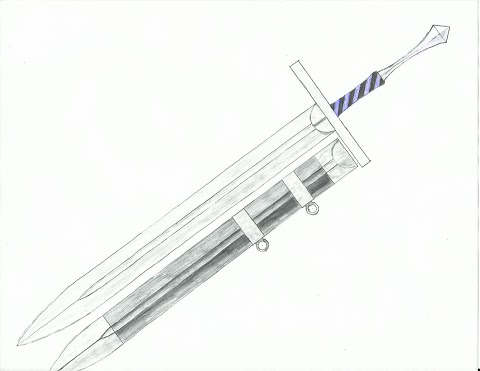
 Attachment: 24.71 KB Attachment: 24.71 KB
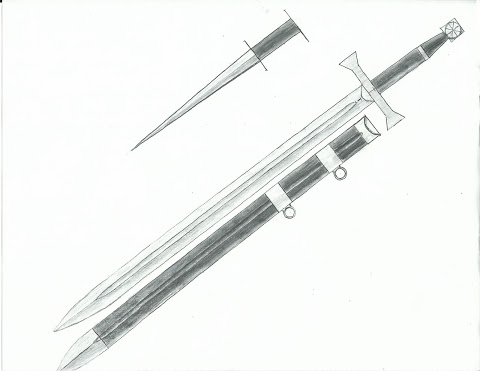
This is Thor's sword, and there is an identical one without the "T" at the base of the blade, belonging to David. The pommel is like an Oakeshott type S, but the pommel's faces are circular rather than octogonal.
 Attachment: 16.17 KB Attachment: 16.17 KB
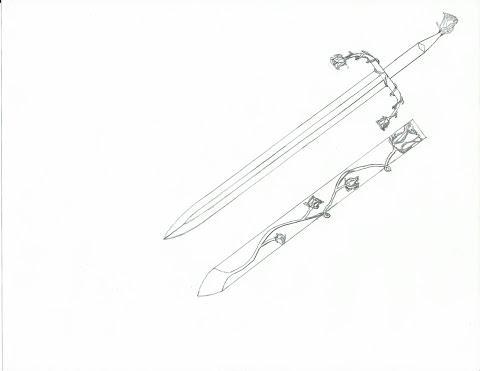
This sword is more artistic than functional, belonging to Rose, later discovered to be princess Lily
 Attachment: 15.13 KB Attachment: 15.13 KB
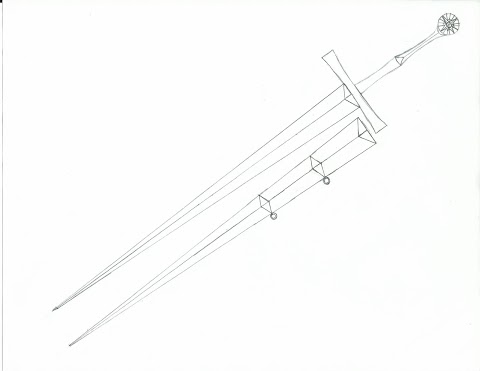
This sword belongs to Elana, later discovered to be princess Rebecca. The pommel is a concave circle for focusing sunlight in the opponnent's eyes at a certain distance and the guard is completely concave as well.
 Attachment: 23.85 KB Attachment: 23.85 KB
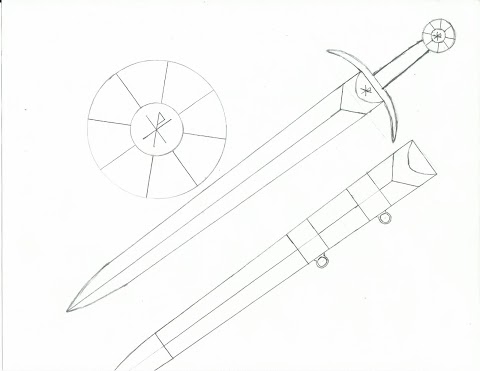
This is the sword and buckler used by both Thor and David.
 Attachment: 15.9 KB Attachment: 15.9 KB
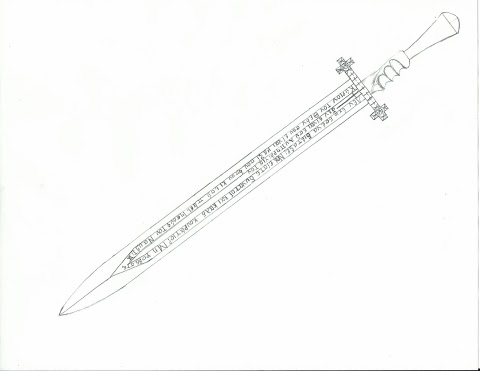
Servus' ceremonial sword. He has a fighting sword too.
Last edited by Andrew Carlson on Sun 04 Nov, 2012 7:25 pm; edited 4 times in total
|
|
  |
 |
Kai Lawson

|
 Posted: Sat 03 Nov, 2012 9:59 pm Post subject: Posted: Sat 03 Nov, 2012 9:59 pm Post subject: |
 |
|
Welcome--it's good to start at an early age. What time period is your writing set in? That'll make a difference in the accuracy of the drawing to real weapons of the time.
"And they crossed swords."
--William Goldman, alias S. Morgenstern
|
|
  |
 |
|
Andrew Carlson
Location: Arizona, United States of America Joined: 02 Nov 2012
Posts: 5
|
 Posted: Sat 03 Nov, 2012 10:16 pm Post subject: Posted: Sat 03 Nov, 2012 10:16 pm Post subject: |
 |
|
|
The time period is really loose, because I have different civilizations all around. Calmar, the main country, however, should be somewhere around 1400. Sorry to be so complicated, but writing this has been my childhood fantasy.
|
|
  |
 |
Kai Lawson

|
 Posted: Sat 03 Nov, 2012 11:12 pm Post subject: Posted: Sat 03 Nov, 2012 11:12 pm Post subject: |
 |
|
It looks as though you're focusing on Western/Central European sword styles, an I correct?
"And they crossed swords."
--William Goldman, alias S. Morgenstern
|
|
  |
 |
Nathan Robinson
myArmoury Admin


|
|
    |
 |
|
Sam Barris
|
 Posted: Sun 04 Nov, 2012 1:02 am Post subject: Posted: Sun 04 Nov, 2012 1:02 am Post subject: |
 |
|
Very nice start! I had a pile of similar drawings when I was about your age that my friends and I used for tabletop RPGs and some very primitive attempts at writing video games. I'm 35 now, and you have two advantages I did not: the internet and the amazing WMA renaissance that has occurred in last few decades. I would suggest that you do a bit of reading on historical swords and the martial arts in which they were used and use those realities as a jumping off point. The principles that govern blade geometry and the human body in motion would remain fairly constant in a fantasy world, and will add a bit of plausibility to your writing that is missing in a lot of fantasy literature. This information is out there, and your ideas have enough potential to deserve putting in the extra work to flesh them out and make them really alive. There's a lot of free information on this website, and more over at ARMA's site. That should be enough to start you off. I would have killed to have these resources like this when I was a teenager.
Good luck and have fun!
Pax,
Sam Barris
"Any nation that draws too great a distinction between its scholars and its warriors will have its thinking done by cowards, and its fighting done by fools." —Thucydides
|
|
   |
 |
|
Andrew Carlson
Location: Arizona, United States of America Joined: 02 Nov 2012
Posts: 5
|
 Posted: Sun 04 Nov, 2012 7:14 am Post subject: Region Posted: Sun 04 Nov, 2012 7:14 am Post subject: Region |
 |
|
|
You are correct, I focused mainly on central Europe, but I tried to pull together everything I knew (which, admittedly, was and is not very much) about all European swords.
|
|
  |
 |
|
Scott Woodruff
|
 Posted: Sun 04 Nov, 2012 8:53 am Post subject: Posted: Sun 04 Nov, 2012 8:53 am Post subject: |
 |
|
|
Some aspects of your fantasy sword designs do capture a very historical "feel." The only "flaw" that really stands out to me is that some of the blades look a bit unwieldy (keeping in mind that they are only seen in 2 dimensions.) Of course if the sword is meant for a warrior of heroic proportions then that is not a problem. I particularly like Elana's sword, though I doubt the efficacy of a concave mirror pommel in a real or realistic fight. Could you describe how you envision the concave guard? I am having a hard time imagining it in 3 dimensions. Overall, I am pretty impressed with your designs and feel that you have a knack that is well worth developing. Keep at it with the research, in particular I suggest really familiarizing yourself with the Oakeshott typology. There is an excellent set of articles on it in the features section. Like Sam, I see an uncanny resemblance between your drawings and some of my own when I was just starting out. I look forward to seeing where you go from here.
|
|
  |
 |
|
Andrew Carlson
Location: Arizona, United States of America Joined: 02 Nov 2012
Posts: 5
|
 Posted: Sun 04 Nov, 2012 2:25 pm Post subject: Reply to Scott Woodruff Posted: Sun 04 Nov, 2012 2:25 pm Post subject: Reply to Scott Woodruff |
 |
|
I'll admit, even the shaded sketches aren't that clear as to proportions and blade proportions, and not all the sketches are exactly centered perfectly or in proportion. I intended Servus' fighting sword to be broad and thin, rather than narrow and thick. I thought it would have a very, very flat diamond- section, almost hollow ground. I mean them all to be of normal proportions, however. As for Elana's sword, it's between that and King Servus' fighting sword for my favorite. I too doubt the effectiveness of a concave pommel, but all those books have something special like that in them. To the concave guard, I envisioned every face being concave. This would give a four-point hammer (similar to some historical war-hammers) for the murder stroke and a cosmetic feature for the other sides. Thanks for the link to the sword-types, but how do you pronounce Oakeshott?
Regards,
Andrew Carlson
|
|
  |
 |
|
Ryan Harting
|
 Posted: Sun 04 Nov, 2012 4:02 pm Post subject: Posted: Sun 04 Nov, 2012 4:02 pm Post subject: |
 |
|
|
As another young person with an interest in fantasy artwork I would say that in general, a lot of your swords look to be at least uniformly usable. The first one looks a bit strange, though; with a type XIIa or XIIIa blade and the elongated scent stopper pommel. Thor's looks rather like a DT5143 (which in my opinion is a very good thing) and Rose's actually looks rather like something I saw on a thread on this site about historical examples of fantastical ornamentation on swords (though I think it was late 16th century, not early 15th). Elana's is a very classical looking type XVa or XVIIIa and with a little more taper the sword from the buckler set would make a very plausible type XIV or XV. The only two mistakes you make are very common: ricassos where they do NOT belong and fullers that start above the crossguard.
|
|
  |
 |
|
Andrew Carlson
Location: Arizona, United States of America Joined: 02 Nov 2012
Posts: 5
|
 Posted: Sun 04 Nov, 2012 7:30 pm Post subject: Reply to Ryan Harting Posted: Sun 04 Nov, 2012 7:30 pm Post subject: Reply to Ryan Harting |
 |
|
Being new to historical arms and very new to Oakeshott, the referencing took a bit of time to decode. For being young, you are clearly far more experienced than I, so congratulations. Just one thing though, could you possibly cite specific points of error?
Thanks,
Andrew Carlson
|
|
  |
 |
|
Sam Barris
|
 Posted: Sun 04 Nov, 2012 11:02 pm Post subject: Posted: Sun 04 Nov, 2012 11:02 pm Post subject: |
 |
|
| Scott Woodruff wrote: | | ...though I doubt the efficacy of a concave mirror pommel in a real or realistic fight. |
I'm having the same problem. The focus of a parabola is easy to calculate, but for something as small as a pommel it may as well have a flat face, because the concaveness would have to be extremely subtle, possibly even beyond the abilities of a period craftsman, or it will be concentrating sunlight at a point an inch or less away. And the intensity of light will also be limited by the area of the reflective surface. A metal shield dished outward might be a more practicable instrument for this tactic, and certainly easier to get the math right, though it would still be most effective at a very specific fighting distance.
I love the idea, though. I'm sure you know that Archimedes used giant concave mirrors to burn the sails of Roman ships.
Pax,
Sam Barris
"Any nation that draws too great a distinction between its scholars and its warriors will have its thinking done by cowards, and its fighting done by fools." —Thucydides
|
|
   |
 |
|
Scott Woodruff
|
 Posted: Mon 05 Nov, 2012 9:29 am Post subject: Posted: Mon 05 Nov, 2012 9:29 am Post subject: |
 |
|
I completely understand the attraction to use a "gimmick" like the concave mirror pommel, it gives you something different and memorable to attach to a character. If you check out the article on combination weapons in the features section, you will see that such "gimmicks" were used during the middle ages and renaissance. I really like your concept for a cross with concave faces and may have to steal your idea for my next sword. Check out this Roman ring-hilt with cross hollow ground in only one direction http://www.myArmoury.com/talk/viewtopic.php?t...ght=spatha
I would not say that you have made any "errors" per se, as your swords are fantasy, but if you want to get them closer to historical there are certainly changes that can be made. Rather than point out specific things that you could change, I would suggest that you just keep on researching and learning, particularly about dynamics, edge geometry, distal taper, nodes, rotation points and all that esoteric stuff. Definitely check out the Peter Johnsson lectures, you will find them invaluable and will learn more in a couple hours than you probably could in 20 hours otherwise. http://www.myArmoury.com/talk/viewtopic.php?t...ht=lecture
|
|
  |
 |
Quinn W.

Location: Bellingham, WA Joined: 02 May 2009
Posts: 197
|
 Posted: Mon 05 Nov, 2012 11:28 am Post subject: Posted: Mon 05 Nov, 2012 11:28 am Post subject: |
 |
|
I think you have received some great advice so far. In essence, while fantasy gives you the freedom to design swords that are not based on specific existing examples, one of the main reasons swords were designed the way they were is because they worked. So as long as the basic laws of physics are still in effect, you will likely see some similarities.
It looks like you already have a pretty good grasp of that concept, so I want to congratulate you there. If you're looking for more information though, I will second what has been said and suggest looking into the Oakeshott typology and basing your swords on those descriptions.
As for specific errors, a few of your blades look a little too heavy and a bit oversized relative to the grips. Thor's and Elena's swords look a lot more proportionately balanced to me than the other ones. Additionally, while blades with parallel edges did exist, it was much more common to have some sort of taper, even if just a slight one.
The grip of Servus' ceremonial sword is very unusual, but since it is decorative you have a lot more leeway.
"Some say that the age of chivalry is past, that the spirit of romance is dead. The age of chivalry is never past, so long as there is a wrong left unredressed on earth"
|
|
   |
 |
|
Lafayette C Curtis
|
 Posted: Tue 06 Nov, 2012 6:33 pm Post subject: Posted: Tue 06 Nov, 2012 6:33 pm Post subject: |
 |
|
The gimmicks don't really have to work at all. Perhaps they were designed for a certain purpose, and advertised as such by the people selling/making the swords, but in the end gimmicks that don't work quite as well as intended are as realistic (indeed, probably more) realistic than ones that don't. It all depends on how well the thing is written, and there are so many ways to narrate the failure at the gimmick (from an actual description of the character trying it during a fight and failing, to the character whining about how the gimmick didn't work in a recently finished fight, and many more).
Anyway, most of the blades shown here are closest in appearance to the Oakeshott types Xa and XIa, so I'd suggest you to read more on those two. Perhaps the most important thing to consider is the fact that most of the fighting blades are broad; medieval European blades that wide tend to have not only a more pronounced profile taper (i.e. the sword narrows more from hilt to point), but also a flatter lenticular (or, in the last couple of centuries, hexagonal) cross-section, unlike the thicker diamond cross-section implied by the presence of the ridge running between the fuller and the point.
Another good type to study if you want a flat cutting blade near the end of the Middle Ages is Type XIX, which was just beginning to become popular in 1400 or so.
Last but not least, don't be afraid to alter, scrap, and redraw your designs many times. They will change, I assure you, just as the characters and the story will morph in the process of planning and writing, often to something entirely different from the original concepts.
|
|
  |
 |
|
Matthew P. Adams
|
 Posted: Tue 06 Nov, 2012 7:13 pm Post subject: Posted: Tue 06 Nov, 2012 7:13 pm Post subject: |
 |
|
Firstly, I think it's just awesome to come onto a historical weapons discussion site, post your artwork, and ask for criticism. Many adults would be too intimidated to do this. Well done in searching for more accuracy.
Secondly, I think its solid advice to simply keep looking at historic examples. The more you observe, the better a feel you get for what looks "right".
Lastly are a few guidelines. As was mentioned a wide blade would be more hexagonal or lenticular. But also the tips wouldn't be so acute. A wide blade that is light enough to wield effectively would need to be thin, and so it would lack the stiffness for an effective thrust. A spatulate tip does make for devastating tip cuts. Look at viking blades for examples of this.
Also, cross guards tend to be as wide as the grip is long. Sometimes just the wooden handle, but sometimes the grip and pommel combined. Having the cross relate to the grip length either way will help with the overall proportions of the sword. Short cross guards are something I see a lot both in illustrations as well as in poorly proportioned "historical recreations".
Also, some of those pommels look a bit long. That being said, I really like where you are going, especially with Elana's XVa. and having all cross guard surfaces concave is an awesome idea. I really like the thought of concave ends giving the cross's tips war hammer ends, and the fact that you combined it with the blade that is most suitable for grasping is either well researched or a ridicules coincidence.
"We do not rise to the level of our expectations. We fall to the level of our training" Archilochus, Greek Soldier, Poet, c. 650 BC
|
|
  |
 |
|
|
You cannot post new topics in this forum
You cannot reply to topics in this forum
You cannot edit your posts in this forum
You cannot delete your posts in this forum
You cannot vote in polls in this forum
You cannot attach files in this forum
You can download files in this forum
|
All contents © Copyright 2003-2025 myArmoury.com — All rights reserved
Discussion forums powered by phpBB © The phpBB Group
Switch to the Basic Low-bandwidth Version of the forum
|

